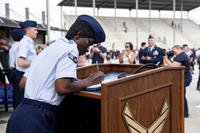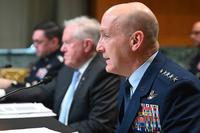VIRGINIA BEACH, Va. - In an inconspicuous building on the Dam Neck Annex is the entrance to what many here call HEL - not a fiery netherworld, but the Harsh Environment Lab where Navy scientists and engineers are developing cutting edge technologies, including 3D printing.
The work being done at HEL marks the first Navy-wide, consolidated effort to bring 3D printing, also known as additive manufacturing, to the service. Officials hope the technology could be used to one day print spare parts on the fly or even manufacture advanced weaponry such as unmanned aerial vehicles.
Three-D printing, while invented in the 1980s, has been a news generator for the past several years. The method counters traditional manufacturing - which takes a material and subtracts from it - by instead adding substances, usually metals or plastics, to create an object. Scientists and engineers have used the technology as a way to manufacture everything from food to parts for fighter jets.
"When advanced manufacturing and 3D printing become widely available, we envision a global network of advanced fabrication shops supported by sailors with the skill sets and training to identify problems and build and make products," said Vice Adm. Phil Cullom, deputy chief of naval operations for fleet readiness and logistics.
"In some ways, sailors with this expertise could be considered military MacGyvers that help us reduce costs and solve logistics problem on the fly," he said.
At HEL, most of the 3D printing work revolves around polymer-based substances. Two printers are located in house where items such as oil caps and medical supplies have been printed, said Jim Lambeth, additive manufacturing lead at Combat Direction Systems Activity Dam Neck, where HEL is based.
The work being done is all part of the Navy's "Print the Fleet" effort dedicated to introducing sailors to 3D printing and brainstorming new ideas, he said.
"Really what the project aims to do is develop procedures and policies for printing parts, how to qualify the parts, deliver the parts ... and how to use these printers," Lambeth said.
Users need only create or download a computer-aided design, or CAD, blueprint to print off a part or trinket, he said.
Print the Fleet began out of the Chief of Naval Operations' Rapid Innovation Cell (CRIC) - a group of junior-level officers who help identify and field emerging technology. Lt. Ben Kohlmann, Print the Fleet project manager and a founding member of the CRIC, started the effort in March of 2013.
"The Navy at large didn't really have a program office or a specific strategy" for additive manufacturing before, Kohlmann said. Various commands and facilities had used the technology, but it was uncoordinated and on an ad hoc basis.
"We were kind of the first effort to bring everybody together into one really concerted effort and bring it to the waterfront," he said.
Print the Fleet has so far created about 20 items, including oil reservoir caps, medical supplies and board game-like pieces for tracking flight operations onboard a ship.
"The models we are printing out for what we call the Ouija boards - which is a model of the flight deck on both amphibious assault vessels and aircraft carriers - might be the most useful [item printed so far] because it really saves on a lot of the cost," Kohlmann said. "A set is between $8,000 to $10,000 ... whereas you can print a similar model for about $300 or$400 and basically modify them at will with different shapes or designs."
Ideas for items to print come from sailors, Kohlmann said.
In June, industry members, servicemen and press were invited to CDSA Dam Neck for its first Print the Fleet maker event, where attendees could see firsthand the Navy's efforts at maturing the technology. Similar events are planned for the future, Lambeth said.
Several different methods of 3D printing exist, each employing different materials. Print the Fleet primarily uses a technique known as material extrusion, which uses plastics, Lambeth said.
"Material, often thermoplastic, is fed through a machine and the nozzle is heated to above the melting point of that thermoplastic," Lambeth said. "The nozzle moves around on the bill platform and deposits pieces of that liquid material. As it cools, it solidifies."
The machine does this layer by layer until the desired object has been created, he said. Two 3D printers that work with polymers are located at HEL.
Print the Fleet also works with other surrounding commands in the Norfolk and Virginia Beach areas that have 3D printers that work with metals, he said.
Cullom said while the Navy is only at the beginning stages of using additive manufacturing, it offers great promise.
"It is my strong belief that 3D printing and advanced manufacturing are breakthrough technologies for our maintenance and logistics functions in the future. We can gain new capabilities to make rapid repairs, print tools and parts where and when we need them, carry fewer spares and ultimately transform our maritime maintenance and logistics supply chain," Cullom said.
Navy logistical supply chains are vulnerable and costly, he said. Three-D printing could help offset some ofthat cost, particularly in austere times, he said.
The Navy is currently working on an official additive manufacturing strategy and vision, said Capt. Frank Futcher, director of the Navy business office and total ownership cost branch at the office of the deputy chief of naval operations for fleet readiness and logistics.
The vision will encompass the Navy's long-term goals over the next 20 to 30 years, he said.
"The strategy that then will follow will be a little more tied to the advancements and progress we need to make over the near term in working towards that vision," he said.
Futcher expects the vision to be released in 2015 and the strategy sometime after that, though no specific date is set, he said.
In November 2013, Chief of Naval Operations Adm. Jonathan Greenert announced OPNAV N4, the office that handles fleet readiness and logistics, would be the lead sponsor for the Print the Fleet effort, taking over for the Navy Warfare Development Center, starting in fiscal year 2015.
"At the time, the CNO did not have a representative on his staff to really oversee [additive manufacturing]," Futcher said. "He was looking for someone to consolidate the reports and then to try and look at this new technology and capability from a high-level perspective, from a strategic perspective."
Before that, various system commands and warfare centers largely worked on their own projects separately, he said. Now, with OPNAV N4 overseeing the Print the Fleet effort, the Navy can look at more than 25 years worth of 3D printing projects and leam from the successes and failures, he said.
There are currently 60 different additive manufacturing-related projects in the Navy, Futcher said. Print the Fleet is a way to operationalize all of them, he said.
The next step involves reaching out to the other services, the Defense Department and the government, he said.
Three-D printing is already being used for tooling, modeling and prototyping within the Navy, Futcher said. He envisioned a time when a printer could be used for larger projects such as making a rotor for a helicopter or an aircraft wing.
Instead of manufacturing hundreds of thousands of parts that then have to be attached together, a printer could simply create an entire wing, Futcher said.
Three-D printers could even be used to make unmanned aerial vehicles, he said.
"If you begin to look out 10 or 20 years I would think it's a possibility that you could in fact print off micro-UAVs," Futcher said. They would start off simple, but eventually would become more sophisticated.
"The complexity will definitely go up where you will be able to print off and embed sensors and circuitry inside the UAV as its printing and potentially download software programs and then mission sets," he said.
Four-D printing is also on the Navy's radar.
Using nanotechnology, robotics and additive manufacturing, scientists are trying to print objects that can respond to their environments, Futcher said. Nanotechnology involves the manipulation of matter at extremely small scales, including the molecular and atomic level.
Dave Barrett, a program analyst for the Navy business operations support office and OPNAV's lead action officer for additive manufacturing efforts, said this type of technology has "huge ramifications for military use."
"With the advancements in 4D printing, you have a capability in which after you print something, you are afforded the ability to change the form and function of the item. It's a whole new domain of capabilities," he said.
For example, a 4D printed wing on an aircraft could change its shape in response to varying degrees of turbulence to better stabilize itself, Barrett said.
Such technology is in its infancy, he said.
Three-D printing, while more mature than 4D printing, is still evolving. Already the technology offers a number of benefits including giving sailors a sense of ownership over machines and systems that they were able to repair using additive manufacturing, Futcher said.
"When a sailor is able to resolve the problem themselves, whether it is designing something or figuring out I can print something off, ... it cultivates a sense of ownership," he said. "You feel much more connected to your platform."
Another benefit is the potential cost savings associated with the technology, Futcher said.
"I definitely think we are going to see some savings," Futcher said. "As you begin to look at future programs, ... whether it's a new shipbuilding program or a submarine program, I think additive manufacturing is going to offer the means to reduce total ownership cost."
Not only can 3D printers be used to fabricate an item, but they can also be used throughout its lifecycle to print out replacement parts, he said.
So far, most Naval 3D printing efforts have been done on land at command centers. Earlier this year, a uPrint printer was put on board the USS Essex, an amphibious assault ship, while it was docked for maintenance.
The uPrint is a high-end desktop printer that uses thermoplastics, Lambeth said. The printer was successfully installed and printed out several parts.
Sailors appeared to pick up the printing process quickly, but had some trouble using the CAD software, he said.
"In the future, printing the CAD models and doing the engineering and design part can be done on our shore facility and they can just print the part" on the ship, he said.
To see if environmental conditions - such as humidity or G-force - onboard a moving vessel would affect 3D printers, engineers printed and tested parts while the Essex conducted sea trials recently, Lambeth said. They were then tested for strength and quality. Analysis of the test is ongoing, he said.
With programs such as Print the Fleet, one of the Navy's goals is to make sailors better aware of how they can use 3D printing. In August, the commander of Naval Surface Force Atlantic held a workshop in Norfolk in conjunction with Print the Fleet, said Lt. Matthew Hippie, an action officer within the group who organized the event. The meeting - which featured experts in the field and printed items - was meant to show sailors on the waterfront what 3D printing capabilities are in the works and how they could get involved, he said.
"[We wanted them to] know that we are accessible and we're not some guy sitting in an office far away," Hippie said.
The overall response was positive, with sailors offering up new applications for the technology, he said.


























